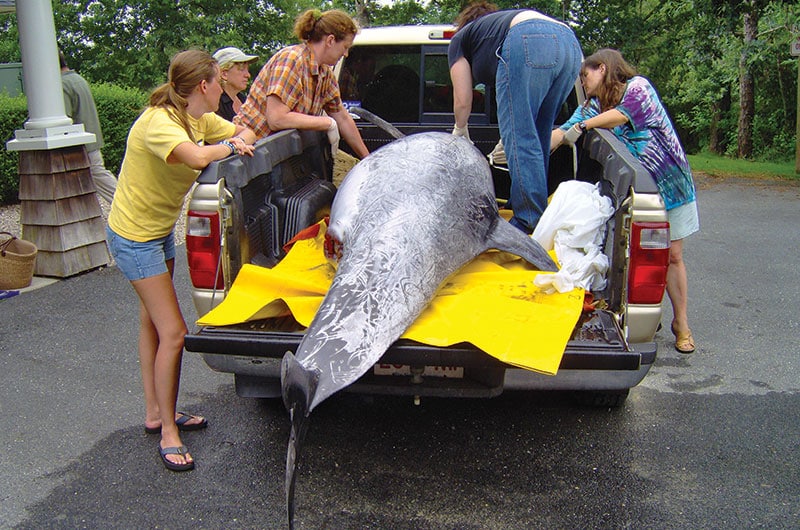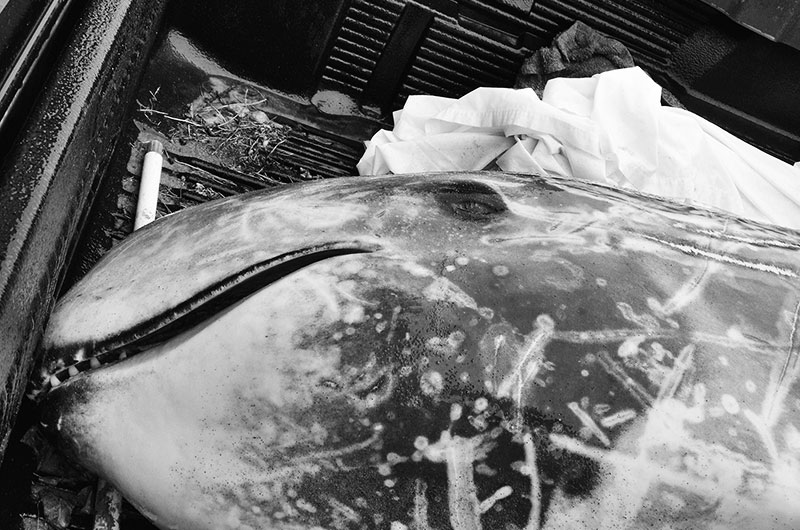• by Dr. Sarah D. Oktay – Director, University of Massachusetts Nantucket Field Station •

We had dug a long trench in the beach with room for its flippers for the eight foot long 800 pound female to rest. Because marine mammals are used to being buoyed up and having a lower effective weight in salt water, their internal organs cannot handle being on dry land and the gravitation pull will start to destroy the internal organs causing it to die. Eventually the decision was made that this animal was not going to make it, and veterinarians from the MSPCA came to euthanize the animal. Many strong men and women in the beach crowd were needed to hoist the poor creature into the back of our retiring Health Department chief, Richard ray’s new truck.
During the necropsy, which I will never forget since it occurred in the back of that same truck in the MSPCA parking lot, we found that the female was pregnant and that she also hosted a huge long green tumor. The baby was folded in half inside the mother. It was heartbreaking. I first noticed the dolphin was a female during the transport to the MSPCA as I closely followed the truck carrying the creature so that an unsuspecting tourist would not have to see the tail end of a deceased dolphin. As we were driving through the streets of Nantucket and making the turn by the Quaker burial ground I realized in horror that it looked like a baby was crowning! Fortunately, we made the short distance without that happening and if I cut off a few people that day, I apologize, I had a good reason.
Risso’s dolphins, Grampus griseus (G. Cuvier, 1812), aka Grampus, are rather large cetaceans with rounded heads, similar in shape to pilot whales. They have a characteristic crease in their melons (the organ in the front of the head used for echolocation) visible from the forehead to the mouth. They have 7 or fewer pairs of teeth located in the front of their lower jaws http://marinebio.org/species.asp?id=357. They are in the Class Mammalia, Order, Cetacea, Suborder, Odontoceti, Family Delphinidae (dolphins) and Genus Grampus. The Risso’s dolphin has been given a great genus and species name which is very descriptive. From the Online Etymology Dictionary (http://www.etymonline.com/index.php?search=Grampus+griseus) we learn that grampus is a word applied to killer whales and other large, dolphin-like creatures since the 1590s, from the earlier graundepose (1520s), altered (by influence of grand) from Middle English graspeys (late 13c.), from Anglo-French grampais, from Old French graspois, craspois ” for whale, (salted) whale meat; blubber; seal,” from Medieval Latin craspicis, literally “great fish” or “fat fish,” from Latin crassus “thick” + piscis “fish” and “griseus “ is a Medieval Latin word for gray. So big fat gray whale it is!
Cetaceans have an even more interesting etymology. “Cetus” is a Latin word most commonly translated as the word for “whale” although its original meaning, “large sea animal,” was more general. It comes from the Ancient Greek (kētos), meaning “whale” or “any huge fish or sea monster.” In Greek mythology, the sea monster Perseus defeated was called Ceto, which is depicted by the constellation of Cetus. In Hermann Melville’s Moby-Dick, the narrator asserts that Perseus was the first whaleman, when he killed Cetus to save Andromeda (from www.absoluteastronomy.com/topics/Perseus ). Cetology is the branch of marine science associated with the study of cetaceans. The order Cetacea contains about ninety species, all marine except for four species of freshwater dolphins. The order is divided into two suborders, Mysticeti (baleen whales) and Odontoceti (toothed whales, which includes dolphins like the Risso’s and porpoises). The species range in size from the Commerson’s Dolphin and Tucuxi, which are smaller than a human, to the Blue Whale, the largest animal that has ever lived. As mammals, cetaceans have characteristics that are common to all mammals: they are warm-blooded, breathe in air through their lungs, bear their young alive and suckle them on their own milk, and have hair, although very little of it. I was pretty enchanted and a little surprised to find out that newborn dolphins have little whiskers when they are borne that quickly fall off.
The American Cetacean Society is an excellent place to start when you are looking for information on dolphins and whales. They are long-lived animals that live an estimated twenty years minimum and possibly up to twice that long. One of the most enigmatic cetaceans, this little-known dolphin has an unusual appearance. Unlike many other dolphins, Risso’s dolphin lacks a beak, and the bulbous head rises almost vertically from the upper jaw and blunt snout. They have distinctive body markings and they have only 7 or fewer pairs of teeth in the front of the lower jaw, and typically none in the upper jaw. The body is robust and powerful, and tapers towards a relatively narrow tail, and a distinct crease runs along the top of the melon. The sickle-shaped dorsal fin is somewhat short for the body length, and the flippers are long and pointed. Risso’s dolphins also have a white anchor-shaped patch, similar to pilot whales, on their ventral/chest area (from throat to stomach).

This striking coloration along with the absence of a beak make the Risso’s dolphin easy to identify. Risso’s specialize in eating squid, but may consume some fish as well. They eat primarily at night as their prey species migrate toward the surface to feed. Squid eggs have been washing up in Sconset by the thousands. Where there are eggs there are squid so that helps to explain why we sometimes see Risso’s dolphins. While the size of their squid prey is unknown, squid beaks from species that grow up to 12 feet in length have been found in the stomachs of stranded Risso’s dolphins! (http://acsonline.org/fact-sheets/rissos-dolphin/).
Risso’s dolphins are gregarious and travel together in pods of 3-30 adults. They can often be found with schools of other dolphins like bottlenose dolphins which has led to hybrids between the two species (dolphins are sexualized animals, I’ll restrain myself from inserting an obvious joke). Due to its offshore habits, relatively little is known about the biology of Risso’s dolphin. Risso’s dolphin shows a preference for deep, shelf-edge waters of 400 to 1,000 meters depth in offshore areas, although it may also inhabit shallower coastal areas, particularly in northern Europe and around oceanic islands
The reproduction of Risso’s dolphin is poorly understood. However, due to its almost cosmopolitan distribution, it is likely that breeding and calving occurs year-round, although it at least peaks between December and April off South Africa. A single calf is born after a gestation period of some 13 to 14 months, and it remains with the female and continues to feed on energy-rich milk for several months. The seasonal movements of this species are equally unclear, but it appears as though some populations in more stable environments stay in the same place all year, while others show northern movements during summer and southern movements during winter.
While at the water’s surface, Risso’s dolphin displays an impressive variety of acrobatic acts, including high speed jumps out off the water, known as breaching, violent tail slapping and bobbing the head. These antics are most likely a form of communication and play. Risso’s dolphins like many other ceteceans also produce a number of sounds, including characteristic signature whistles, and many of these vocalizations are important for detecting prey through echolocation.
According to http://www.arkive.org/rissos-dolphin/grampus-griseus/ (access June 7th 2015): “Risso’s dolphin is widely distributed throughout the world’s temperate and tropical waters, ranging from Newfoundland, the Gulf of Alaska and the North Sea, south towards South America, Southern Africa, Australia and New Zealand. The species’ range appears to be limited by water temperature, with this dolphin most abundant in waters between 15 and 20 degrees Celsius, and rarely occurring in waters below 10 degrees Celsius. Risso’s dolphin is also found in a number of partially enclosed waters, including the Red Sea, Gulf of Mexico and Mediterranean Sea, and appears to migrate northwards during winter, with some individuals sighted as far north as the Gulf of Alaska and the Shetland Islands.“ That is the farthest north they will go and they do not get into polar waters to the south.
According to the New England Aquarium’s web site there have been a two mass strandings of four individual Risso’s Dolphins since 1973 (http://www.neaq.org/conservation_and_research/projects/conservation_medicine/rescue_and_rehabilitation/learn_about_rescue_and_rehabilitation/animal_strandings/mass_strandings.htm).
Locally we see the white sided dolphin, the common dolphin, pilot whales, Risso’s dolphins, striped dolphins, pygmy sperm whales, and harbor porpoises. There are many factors suspected to cause or induce strandings, from acoustic damage from naval testing to confusion from pollutant poisoning to simple ailments that affect toothed whales the same as other mammals like infections and tumors. Our narrow harbor and creeks also make it very difficult for dolphins to escape if they come into Nantucket Harbor greedily chasing some food; the long skinny stretch of the harbor and incursion of multiple cuspate spits causes some species to ping pong back and forth trying to find the exit and a tide that works for their escape. There are no dolphin gas stations to pull over and ask for directions.
Learn more about marine mammals on Nantucket by going to the Nantucket Marine Mammal Conservation Program web page at http://www.nantucketmarinemammals.org/. If you see a stranded creature call the Marine Mammal Stranding hotline at 866-755-NOAA (6622) or the Environmental Police Officer Keith Robinson at (508) 257-6932.
To read about other strandings please look at these past YI articles:
- http://yesterdaysisland.com/the-boy-who-cried-shark-fin-sighting-101/
- http://yesterdaysisland.com/archives/science/8.php
- http://yesterdaysisland.com/archives/science/14.php
Citation: “Risso’s Dolphins, Grampus griseus ~ MarineBio.org.” MarineBio Conservation Society. Web. Accessed Monday, June 08, 2015. <http://marinebio.org/species.asp?id=357>. Last update: 1/14/2013 2:22:00 PM ~ Contributor(s): MarineBio


